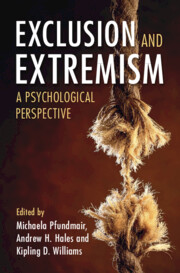Book contents
- Exclusion and Extremism
- Exclusion and Extremism
- Copyright page
- Dedication
- Contents
- Contributors
- Introduction
- Part I The Link between Exclusion and Extremism
- 1 Ostracism and Extremism
- 2 Exclusion and Radicalization
- 3 In the Realm of Action
- 4 Seeking the Self in the Extreme
- 5 Buying the Blackpill
- Part II Drivers of the Exclusion–Extremism Link
- Part III Topics Related to the Exclusion–Extremism Link
- Index
- References
3 - In the Realm of Action
Social Exclusion as a Catalyst for Terrorism
from Part I - The Link between Exclusion and Extremism
Published online by Cambridge University Press: 16 May 2024
- Exclusion and Extremism
- Exclusion and Extremism
- Copyright page
- Dedication
- Contents
- Contributors
- Introduction
- Part I The Link between Exclusion and Extremism
- 1 Ostracism and Extremism
- 2 Exclusion and Radicalization
- 3 In the Realm of Action
- 4 Seeking the Self in the Extreme
- 5 Buying the Blackpill
- Part II Drivers of the Exclusion–Extremism Link
- Part III Topics Related to the Exclusion–Extremism Link
- Index
- References
Summary
Norwegian terrorist Anders Breivik was reported to have been excluded throughout his life, much like German extremist Fabian D. In many cases of terrorism like these, social exclusion is found in the life course of terrorists. This chapter therefore explores the relationship between exclusion and terrorism in greater depth. First, central concepts are defined and explained. The chapter then focuses on theoretical and, in particular, empirical findings on the exclusion–terrorism link. According to these findings, there is a causal relationship between exclusion and a terrorist mindset. However, the link between exclusion and terrorism is probably not direct and instead works indirectly, through processes such as deprived needs and higher social susceptibility. Ultimately, exclusion is likely to act as an early cognitive opener for terrorism via its individual- and group-level consequences. A corresponding exclusion–terrorism model is postulated. The chapter concludes with directions for future research and practical implications regarding the exclusion–terrorism link.
Keywords
- Type
- Chapter
- Information
- Exclusion and ExtremismA Psychological Perspective, pp. 51 - 73Publisher: Cambridge University PressPrint publication year: 2024

